Early on, people recorded history even if they didn’t yet understand the importance of doing so. Cave art, which was primarily used for communication, symbolic, and religious purposes, now gives us an insight into the lifestyle of our ancestors. The writings of the king’s names on the Palermo Stone in Egypt are already one of the earliest examples of intentional historical recordings. Even though these aren’t typical ways we document the past nowadays, they still provide us with ample information about it.
Sadly, the amount of recorded history we produced over thousands of years makes it easy to remember the pivotal moments and forget the others. That’s why today we’re featuring historical events and stories from the Instagram account “Past Preserved”—to bring light to happenings from the past people might have forgotten. Scroll down to find them below, and don’t forget to upvote the ones that definitely shouldn’t fade from our memory.
#1
Pablo Picasso’s first self-portrait, painted in 1896 when he was just 15, reflects his early mastery of traditional techniques. Nearly eight decades later, his final self-portrait, created in 1972 at the age of 90, offers a raw and emotional glimpse into his confrontation with mortality. These works bookend the incredible evolution of one of history’s most iconic artists
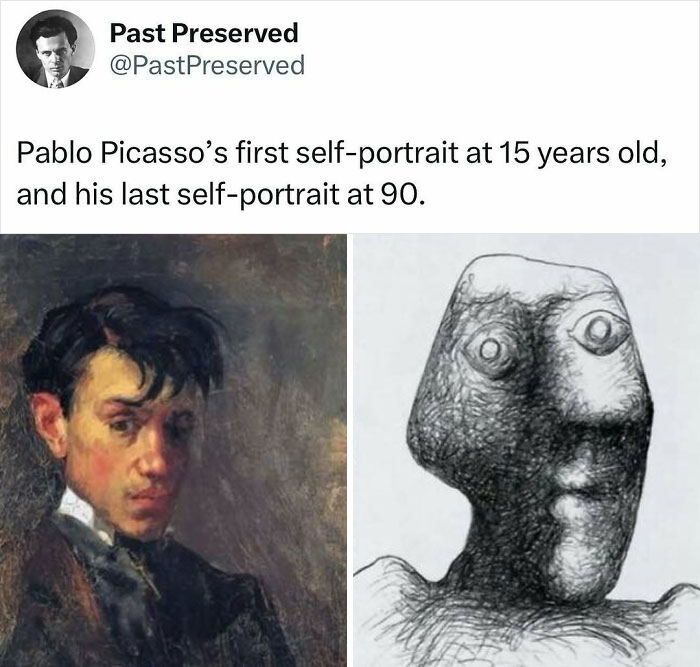
Image credits: pastpreserved
#2
The 1985 Nissan 300ZX, part of the Z31 generation, marked a significant evolution in the Z-car lineup with its sleek, aerodynamic styling and focus on performance. It featured a 3.0-liter V6 engine (Nissan’s VG-series), with turbocharged variants offering 200 horsepower, making it a capable and exciting sports car for its time. Innovative features like an optional digital dashboard, adjustable shock absorbers, and advanced climate control highlighted Nissan’s commitment to modern technology. With a balance of power, comfort, and reliability, the 300ZX became a symbol of accessible performance in the 1980s

Image credits: pastpreserved
#3
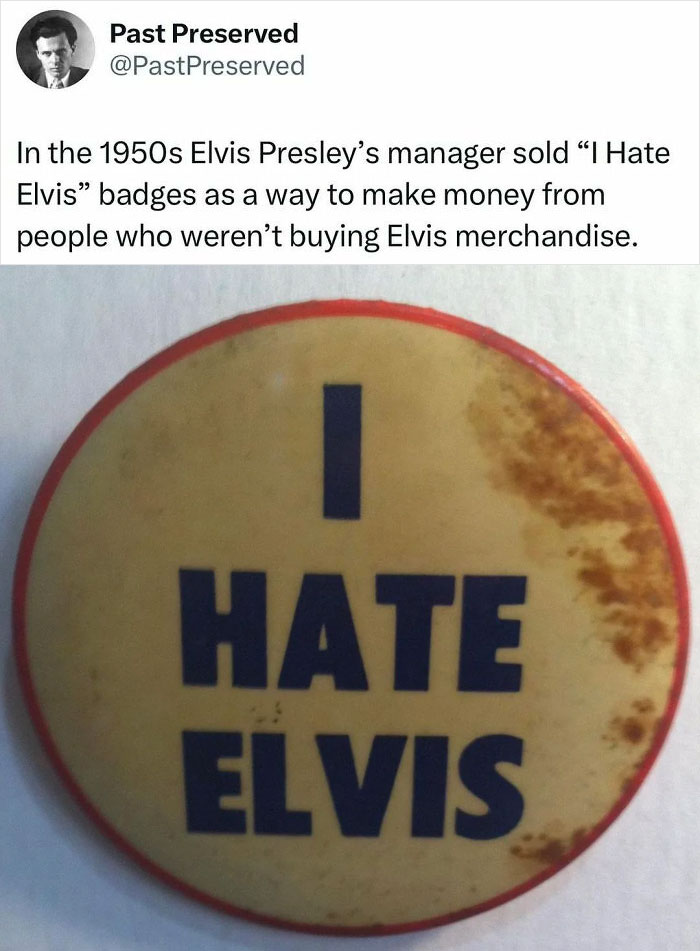
Image credits: pastpreserved
Previously, we were lucky enough to have a chat with Margot Note, an expert archival consultant and founder of Margot Note Consulting LLC. She believes that one of the best ways to record history is through photography due to its unparalleled accuracy and immediacy.
“Unlike oral traditions or written records, which are subject to interpretation, memory loss, or bias, photographs provide a direct and detailed representation of a moment in time. This allows future generations to see historical events, people, and places as they truly appeared, offering a level of authenticity and emotional connection that earlier methods may lack,” she explained.
#4
In the early 1970s, Sylvester Stallone was struggling to make ends meet as an aspiring actor. In 1971, Stallone sold his beloved bullmastiff, Butkus, for $40 outside a 7-Eleven, as he could no longer afford to feed him. Stallone was hugely affected by having to part with his best friend – Butkus had been his loyal companion during his most difficult times, offering him comfort as he lived in a small, roach-infested apartment. Four long years later, after Stallone’s screenplay for Rocky sold and his career finally began to take off, he immediately sought to buy Butkus back. The new owner, knowing Stallone’s situation, demanded $15,000, which Stallone paid without hesitation. The two were reunited in 1975, and Butkus even went on to star in the first two Rocky films alongside Stallone. They remained inseparable until Butkus passed away in 1981.
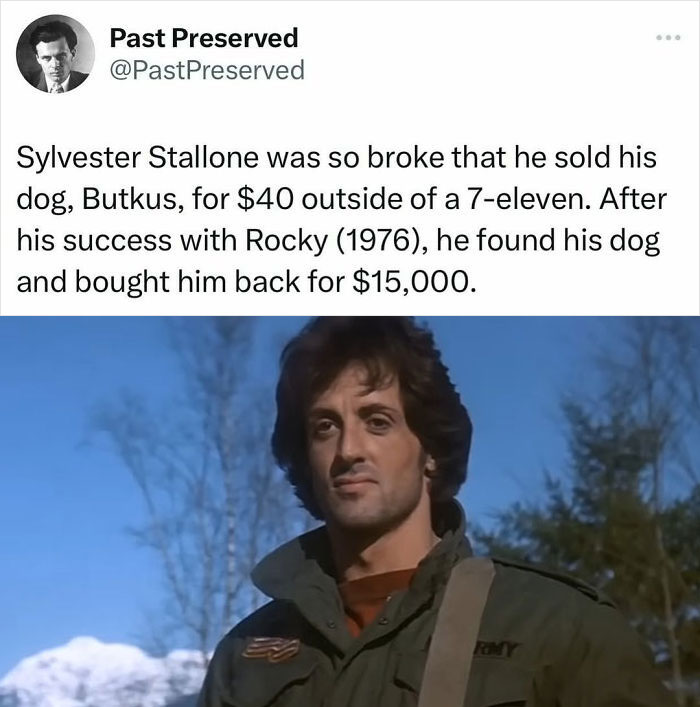
Image credits: pastpreserved
#5
Tsutomu Yamaguchi was in Hiroshima on August 6, 1945, when the first atomic bomb was dropped. He survived the blast, suffering burns and temporary blindness, but managed to return to his hometown of Nagasaki just in time for the second atomic bomb on August 9. Remarkably, Yamaguchi survived both explosions, making him the only officially recognized survivor of both atomic bombings. Despite the immense trauma, Yamaguchi lived to the age of 93 and became a passionate advocate for nuclear disarmament. His incredible story of survival serves as both a testament to human resilience and a sobering reminder of the devastating power of nuclear weapons.

Image credits: pastpreserved
#6
David Bowie’s unique eye appearance was the result of a teenage fight, not a natural eye color difference. At 15, Bowie got into a scuffle with friend George Underwood over a girl, and Underwood punched him in the left eye. The blow permanently damaged Bowie’s pupil, causing it to remain dilated—a condition known as anisocoria—giving the appearance of two different eye colors. This eye injury became one of Bowie’s most striking features, adding to his mysterious and unconventional image. Despite the injury, Bowie and Underwood remained close friends, and Bowie later credited Underwood with inspiring some of his iconic style choices that helped shape his persona

Image credits: pastpreserved
She even went as far as to say that the invention of photography, democratized documentation of history. “Previously, recording history often required specialized skills like writing or artistry, which were limited to certain classes or institutions. Photography, especially with modern technology, enables a broader range of people to document their lives and environments, creating a more inclusive and diverse historical record.”
#7
Charles Darwin, best known for his work on evolution, once owned a remarkable Galápagos giant tortoise named Harriet. Believed to have been collected by Darwin during his 1835 voyage on the HMS Beagle, Harriet eventually made her way to Australia, where she became an iconic figure. Spanning over 175 years, her incredible life connected two of history’s greatest naturalists. In the late 20th century, Harriet found a new caretaker: Steve Irwin. At Irwin’s Australia Zoo, she became a beloved ambassador for her species, sparking conversations about conservation. Though it’s debated whether Darwin personally collected her, Harriet’s story is a powerful reminder of the enduring connection between humans and the natural world

Image credits: pastpreserved
#8
Salvador Dalí, known for his eccentricities, once used his art as a form of payment at restaurants. Rather than settle his bills with cash, he would often sketch on the back of his meal checks, leaving behind unique, surreal doodles. The restaurant owners, recognizing the value of his work, accepted these sketches as payment instead of money. This practice reflected Dalí’s belief in the intrinsic value of his art, even in everyday situations. By transforming a simple restaurant receipt into a piece of his surrealist world, Dalí turned mundane transactions into a statement about the cultural and financial worth of art during his time.
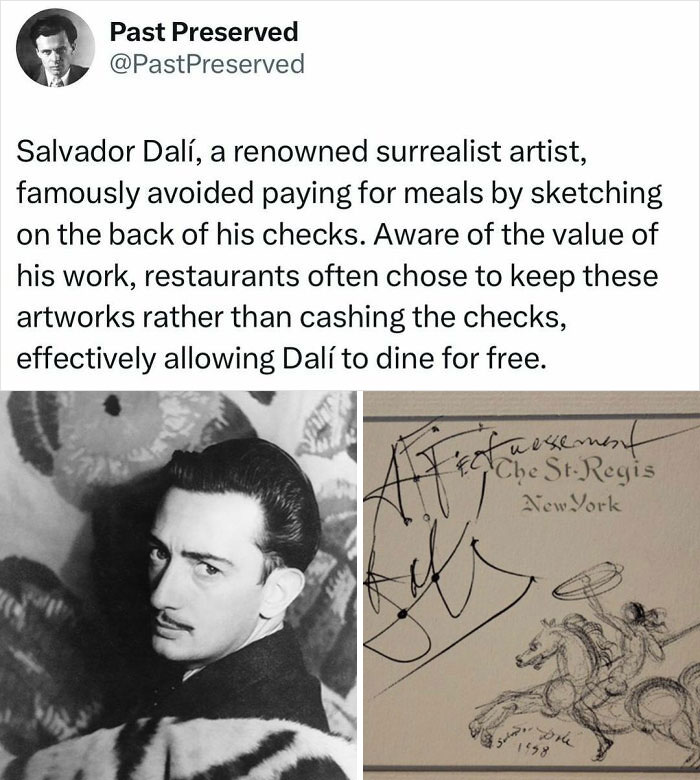
Image credits: pastpreserved
#9
In the final years of his life, Albert Einstein remained engrossed in his work, still searching for a unified field theory that could reconcile the laws of physics. Though he had stepped back from public life, he continued to correspond with colleagues and remained engrossed in his studies til the end. By 1955, his health had worsened due to an abdominal aortic aneurysm. Refusing surgery, Einstein passed away on April 18, 1955, at the age of 76 in Princeton Hospital. While reporters flocked to the hospital, Life magazine photographer Ralph Morse chose a different path. Instead of joining the media frenzy, Morse went to Einstein’s office at the Institute for Advanced Study. There, he captured poignant photos of Einstein’s desk, just as he had left it—papers and books scattered in disarray, untouched since his last moments of work. These images, haunting and intimate, immortalized the quiet brilliance of Einstein’s life, symbolizing his relentless pursuit of knowledge until the very end.
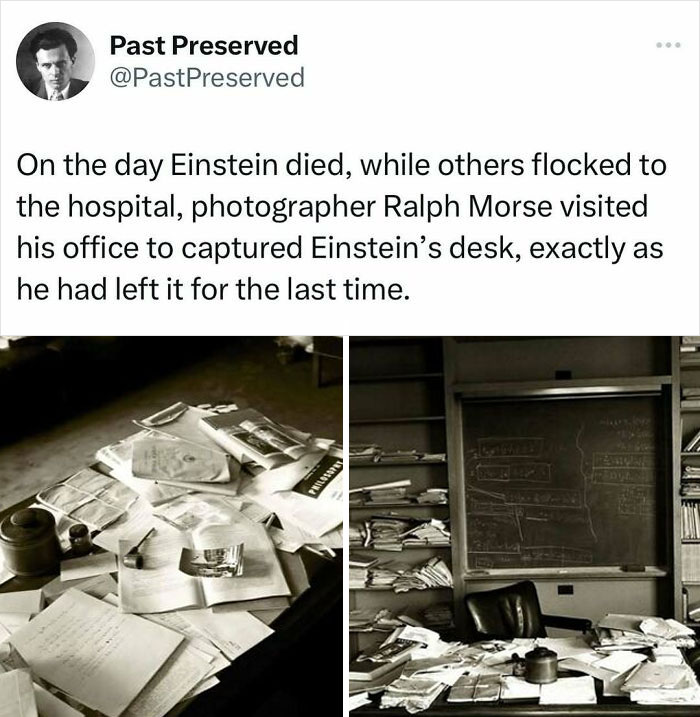
Image credits: pastpreserved
Of course, like with anything, using photography to record the past also has its limitations. “Like earlier methods, it can be selective and influenced by the perspective of the photographer. Despite this, its immediacy, accessibility, and ability to preserve fleeting moments make it a uniquely powerful tool for recording history, complementing rather than entirely replacing earlier methods,” Margot said.
#10
Bologna, Italy, is famous for its medieval towers, which once numbered over 100 in the 12th and 13th centuries. Built by wealthy families as symbols of power, these towers also served defensive purposes. Today, fewer than 20 remain, with the most iconic being the Asinelli and Garisenda towers. The Asinelli Tower, at 97.2 meters (318 feet), is the tallest leaning medieval tower in the world, while the shorter Garisenda leans dramatically due to foundational issues. These towers rose alongside Bologna’s prominence as a center of trade and education. While many were demolished or repurposed, the Asinelli Tower was preserved and used as a prison and lookout in the 14th century. Visitors today can climb its 498 steps for stunning views of the city and the Emilia-Romagna region. These remaining towers stand as reminders of Bologna’s competitive city-state era, where towering structures displayed wealth and influence

Image credits: pastpreserved
#11
Charlie Chaplin, one of the most iconic figures in film history, is famously said to have lost a Charlie Chaplin lookalike contest. According to legend, during the height of his fame in the 1920s, Chaplin entered the contest anonymously, only to be eliminated early or finish without winning. The irony of the story lies in the fact that his distinctive look—complete with the bowler hat, cane, and mustache—was so widely imitated that even the man himself couldn’t measure up to his imitators. While the tale has been widely circulated, its details remain unclear, with some reports claiming it happened in California and others suggesting Seattle or San Francisco. Whether true or an urban myth, the story endures as a humorous reminder of Chaplin’s immense cultural impact and the global recognition of his beloved Tramp character

Image credits: pastpreserved
#12
When Sony released the first Walkman in 1979, it came with an interesting feature: two headphone jacks. The designers believed that listening to music in public could be seen as antisocial or rude, so they included the second jack to encourage sharing the experience with a friend. Along with this, the Walkman came with a “hotline” button, which temporarily lowered the volume so users could talk without removing their headphones. However, the feature of two headphone jacks wasn’t widely used as Sony expected. People preferred the personal, solitary experience the Walkman provided, which was its main appeal. As a result, later models removed the second headphone jack, focusing instead on enhancing the user’s individual listening experience. This change marked a shift in how people interacted with portable music, embracing the Walkman as a personal device.

Image credits: pastpreserved
The photos of historical events that Margot feels are very important to humanity are the “Migrant Mother” by Dorothea Lange, which depicts the cost of the Great Depression, “Raising the Flag on Iwo Jima” by Joe, which embodies the resilience people showed during World War II, and “Earthrise” by William Anders, which revealed how Earth looks from space, inspiring environmental awareness.
#13
During World War II, a Great Dane named Juliana became a canine hero. In 1941, a German incendiary bomb landed in her owner’s home in England. Without hesitation, Juliana urinated on the device, extinguishing it before it could cause an explosion. Her quick thinking saved lives and earned her a medal for bravery from the Blue Cross, an animal welfare charity. Juliana’s story doesn’t end there—she received a second Blue Cross Medal in 1944 for alerting her owners to a fire in their shop. While her first act of heroism is often recounted with humor, it underscores the incredible instincts and intelligence of animals, even in the face of war.

Image credits: pastpreserved
#14
Wojtek, a bear adopted by the Polish Army during World War II, became an iconic member of the 22nd Artillery Supply Company. Found as a cub in Iran in 1942, he was trained by soldiers to carry artillery shells and supplies, and even participated in the Battle of Monte Cassino in 1944. Due to his contributions, Wojtek was officially enlisted as a soldier, given a rank, and issued a service number. Wojtek’s unusual military service included enjoying beer with the troops, and he became a beloved mascot. After the war, he was relocated to the Edinburgh Zoo in Scotland, where he lived until his death in 1963. His story remains a testament to the bond between soldiers and the animals they encountered during wartime.

Image credits: pastpreserved
#15
In the 2nd century CE, Gaius Appuleius Diocles became the highest-paid athlete in history as a Roman charioteer, earning 35,863,120 sesterces during his 24-year career. That’s equivalent to around €15 billion today. Diocles competed in over 4,000 races, winning 1,462, and his daring performances made him a legend in ancient Rome, where chariot racing was as popular as it was dangerous. Diocles’ fortune wasn’t just from prize money but also sponsorships and the immense financial stakes of Roman sports. His fame rivaled that of emperors, and his record-breaking career remains a testament to the lasting allure of athletic achievement. Even today, his name symbolizes the extraordinary rewards that can come with mastery in sports.

Image credits: pastpreserved
Meanwhile, her personal favorite photo capturing a historical moment is the first selfie taken by Robert Cornelius in 1839. “This image fascinates me not only for its pioneering technique in photography but also for its deeply human quality—a quiet moment of self-reflection captured in the dawn of photographic history. It’s remarkable to consider that the instinct to document ourselves, our lives, and our essence transcends time and technology. This photograph reminds me that archival work isn’t just about preserving the past; it’s about safeguarding humanity’s ongoing story for the future,” she told us.
#16
Ludwig van Beethoven, one of the greatest composers in history, lost his hearing in his late 20s and was almost completely deaf by the time he composed many of his masterpieces. Determined to continue his work, Beethoven discovered he could “hear” his music through bone conduction. By biting a metal rod or stick connected to his piano, he felt the vibrations travel through his jawbone to his inner ear, allowing him to sense the pitch and tone of his compositions. This innovative method enabled Beethoven to create some of his most iconic works, including his Ninth Symphony. His use of bone conduction not only showcased his resilience but also highlighted his extraordinary ability to adapt in the face of adversity

Image credits: pastpreserved
#17
Ancient Roman concrete has proven to be far more durable than most modern-day concrete. Unlike modern mixtures that degrade over time, Roman concrete is known for its ability to actually strengthen when exposed to seawater, a quality found in structures like the Pantheon and coastal piers that have stood for nearly two millennia. The secret lies in a unique blend of volcanic ash (often collected from Mount Vesuvius), lime, and seawater. These minerals react chemically over time to form new crystalline structures, fortifying the strength and durability of the concrete itself. This “self-healing” property allowed Roman marine structures to endure and even thrive despite millennia of weathering, leaving modern scientists studying its composition as they seek to replicate its strength for future construction.

Image credits: pastpreserved
#18
Freddie Mercury’s dedication to his music never wavered, even in his final days. During his last recording sessions with Queen, he was so weak from illness that he could only sing a few lines at a time before needing to rest. Despite the immense physical toll, he insisted on pushing through, determined to leave behind as much music as possible. His final vocals, recorded for Made in Heaven, stand as a testament to his relentless passion and artistic spirit. Though his health was rapidly declining, Mercury remained focused on his craft, telling his bandmates, “I’ll sing it, darling. I’ll give it my all.” His voice, though fragile, carried the same power and emotion that had defined his legendary career. Even in his final moments, he proved that his love for music was stronger than anything—even the illness that was taking him away

Image credits: pastpreserved
Sticking to the theme of historical events that shouldn’t fade from our memory, in another previous interview we spoke with American history writer and author of Swastika Nation: Fritz Kuhn and the Rise and Fall of the German-American Bund, Arnie Bernstein, and high school history teacher and social media personality Jaclyn Richie, who unanimously agreed that the Holocaust and all of its horror should never be forgotten.
#19
Mary Shelley, best known as the author of Frankenstein, kept a macabre memento after her husband, poet Percy Bysshe Shelley, passed away in 1822. Percy lost his life in a sailing accident, and when his body was cremated, his heart did not fully burn, possibly due to calcification from an earlier illness. Mary kept the preserved heart wrapped in his own poetry and stored it in her writing desk for the rest of her life. The heart was eventually buried alongside Mary’s son, Percy Florence, after her passing in 1851. The story is a haunting glimpse into the gothic life of the woman who created one of literature’s most enduring monsters

Image credits: pastpreserved
#20
Cleopatra VII, the last active ruler of the Ptolemaic Kingdom of Egypt, lived from 69 BC to 30 BC. The Great Pyramid of Giza, however, was constructed around 2,560 BC, nearly 2,500+ years before Cleopatra’s birth. To put this in perspective, Cleopatra lived closer to the invention of the iPhone (2007 AD) than to the construction of the Great Pyramid. This surprising timeline highlights just how ancient the pyramids were, even during Cleopatra’s era

Image credits: pastpreserved
#21
Vincent van Gogh’s artistic career might never have flourished without the unwavering support of his younger brother, Theo. Theo provided the financial stability and emotional encouragement that allowed Vincent to focus entirely on his art, despite his struggles. Tragically, Vincent passed away in 1890, and Theo followed just six months later after battling his own health issues.The bond between the brothers was profound, and they now rest side by side in the cemetery of Auvers-sur-Oise, France. Their connection is immortalized not only through Vincent’s masterpieces but also through the letters they exchanged, which reveal the depth of their relationship
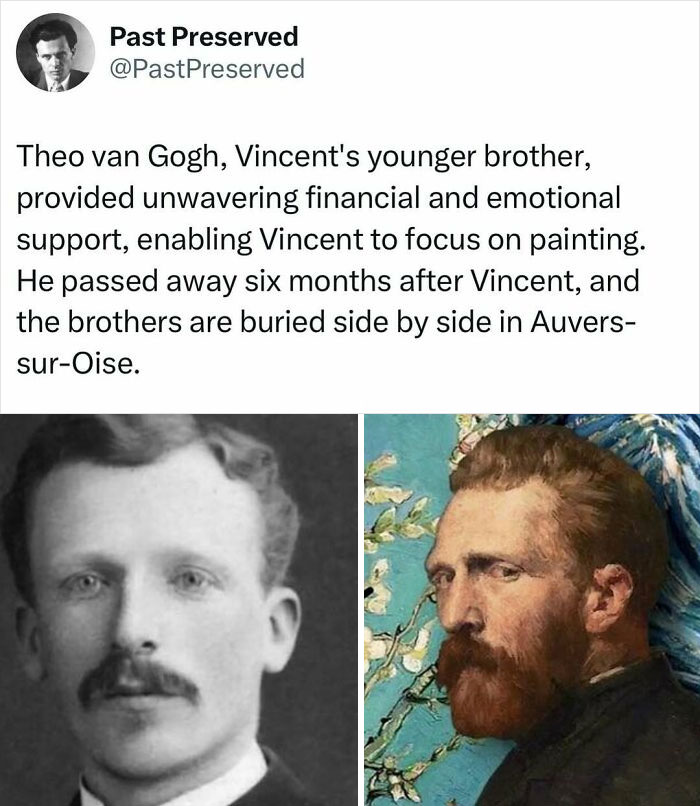
Image credits: pastpreserved
In addition, Richie mentioned the Civil Rights Movement. “The Holocaust is a reminder of the dangers of hate, prejudice, and unchecked power. The Civil Rights Movement, meanwhile, showed the world the power of collective action in the fight for equality and justice. Both serve as powerful lessons in the need for compassion, vigilance, and courage,” she said.
#22
In 1839, Robert Cornelius, an amateur chemist and photography enthusiast, captured what is widely regarded as the first photographic self-portrait, or “selfie.” Using a daguerreotype process, Cornelius positioned himself in front of his homemade camera in his family’s lamp store in Philadelphia. After removing the lens cap, he remained still for several minutes to expose the plate and then wrote on the back of the final image: “The first light picture ever taken”
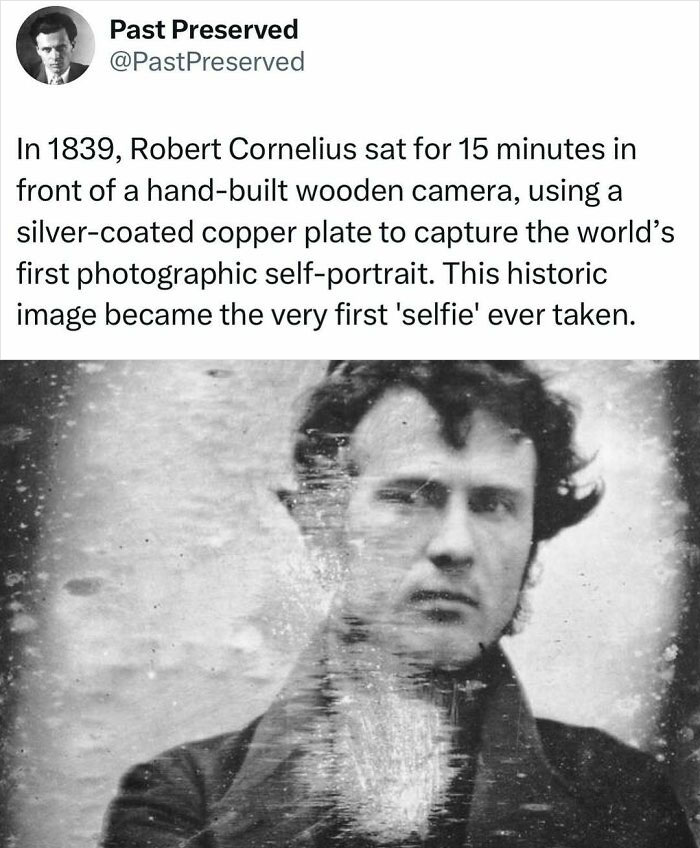
Image credits: pastpreserved
#23
Before becoming the 16th President of the United States, Abraham Lincoln was an accomplished wrestler. His towering 6’4” frame and physical strength made him a formidable opponent in the ring. Out of roughly 300 matches, Lincoln suffered only one recorded loss, dominating opponents with a unique blend of technique and brute force. His reputation even earned him the nickname “The Wrestling Champion of the Region” during his youth in Illinois. Lincoln’s wrestling skills were so noteworthy that he was posthumously inducted into the National Wrestling Hall of Fame in 1992. This little-known aspect of his life highlights his competitive spirit and resilience—traits that would later define his leadership during one of the most tumultuous periods in American history

Image credits: pastpreserved
#24
At the 1973 Academy Awards, Marlon Brando won Best Actor for The Godfather, but he refused to accept the Oscar. Instead of attending the ceremony, he sent Apache actress and activist Sacheen Littlefeather to decline the award on his behalf. She took the stage and explained that Brando was boycotting in protest of Hollywood’s negative portrayal of Native Americans in film and television, as well as in response to the ongoing standoff at Wounded Knee between federal agents and members of the American Indian Movement. Littlefeather’s speech was met with a mix of applause and boos from the audience, and she later revealed that security had to prevent actor John Wayne from forcibly removing her from the stage. Brando’s protest became one of the most famous moments in Oscar history, sparking conversations about Native American representation in media. However, Littlefeather faced industry backlash, with some questioning her Native heritage—claims she firmly denied throughout her life. In 2022, the Academy formally apologized to her for the mistreatment she endured following the speech
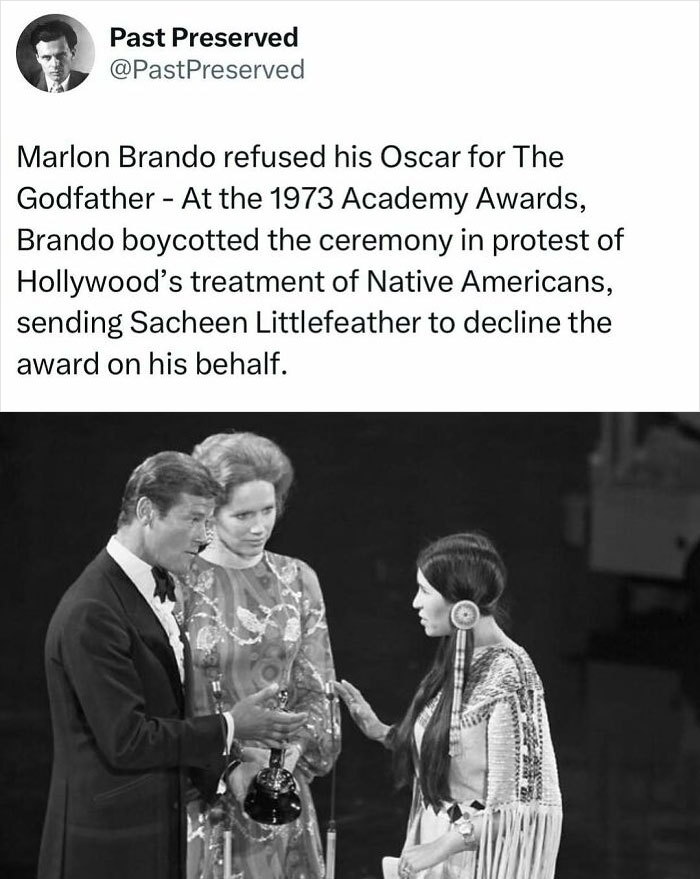
Image credits: pastpreserved
#25
Napoleon Bonaparte’s height has been the subject of enduring myth, but contrary to popular belief, he wasn’t unusually short. Standing around 5’6”–5’7”, he was of average height for a Frenchman of his time. The misconception stems from British propaganda during the Napoleonic Wars, which sought to belittle him—literally and figuratively—to undermine his authority and reputation. Additionally, confusion arose because French and British measurements differed slightly, with French inches being longer than British ones. This myth became so ingrained in popular culture that “Napoleon complex” is now shorthand for short individuals overcompensating with ambition or aggression. However, Napoleon’s actual stature in history is defined by his military brilliance and political influence, not his physical height. The story is a timeless reminder of how propaganda and media manipulation shape public perception—something still highly relevant in today’s information age.

Image credits: pastpreserved
#26
In July 1518, the city of Strasbourg (then part of the Holy Roman Empire, now in France) experienced a bizarre phenomenon known as the “Dancing Plague.” It began when a woman, referred to as Frau Troffea, started dancing fervently in the streets. Over the next month, approximately 400 people joined her, dancing uncontrollably for days on end. Many collapsed from exhaustion, and some reportedly died from heart attacks or strokes. The exact cause remains a mystery, with theories ranging from mass hysteria to ergot poisoning

Image credits: pastpreserved
#27
Robert Hanssen, one of the most notorious spies in U.S. history, was ironically tasked with finding the very mole he secretly was. In 1994, as the FBI grew suspicious of internal leaks, Hanssen—an experienced counterintelligence agent—was assigned to help investigate the breach. Unbeknownst to his colleagues, he had been selling U.S. secrets to the Soviet Union and later Russia since the late 1970s. Hanssen’s betrayal led to the exposure and execution of American double agents within Soviet intelligence, severely crippling U.S. operations. He also revealed highly sensitive military secrets, including nuclear strategies and U.S. eavesdropping efforts, causing immense damage to national security. For years, Hanssen’s insider knowledge allowed him to evade detection, but in 2001, after an extensive investigation, the FBI received key intelligence that pointed to him as the mole. In a carefully orchestrated sting operation, Hanssen was caught red-handed making a “dead drop” of classified materials in a park near his home. His arrest brought an end to one of the most damaging espionage operations in U.S. history, exposing the deep vulnerabilities within American intelligence agencies.

Image credits: pastpreserved
#28
In 1750 BC, in ancient Mesopotamia, a man named Nanni wrote what is considered the world’s first recorded complaint. Inscribed on a clay tablet in Akkadian cuneiform, Nanni sent his grievance to a merchant named Ea-nasir. The issue? Ea-nasir had promised to sell Nanni high-quality copper but instead delivered a lower-grade product. To make matters worse, when Nanni’s servant tried to address the matter, Ea-nasir reportedly treated him poorly, further fueling Nanni’s frustration. This clay tablet reveals that bad customer service isn’t a modern invention—it’s been around for thousands of years. The “complaint tablet” was discovered in the ruins of the ancient city of Ur, showcasing the sophistication of trade systems and personal accountability at the time. Whether it’s emails today or clay tablets in the past, it seems some things never change!

Image credits: pastpreserved
#29
Marie Curie was a pioneering physicist and chemist who made groundbreaking discoveries in radioactivity. She was the first woman to win a Nobel Prize and remains the only person to have won in two different scientific fields—Physics in 1903 (shared with her husband, Pierre Curie, and Henri Becquerel) and Chemistry in 1911 for her discovery of radium and polonium. Her research on radioactive elements revolutionized medicine and physics, laying the foundation for advancements in cancer treatment and nuclear energy. However, her extensive work with radioactive materials, often without proper protection, ultimately led to her death from aplastic anemia in 1934, a condition linked to prolonged radiation exposure. Curie’s research materials, including her notebooks, are still highly radioactive due to prolonged exposure to radium. These documents, housed at the Bibliothèque Nationale de France, are stored in lead-lined boxes to protect against radiation, and anyone wishing to handle them must wear protective gear and sign a waiver. The radiation levels are expected to remain dangerous for another 1,500 years, as radium-226, one of the primary contaminants, has a half-life of 1,600 years. Despite this, Curie’s legacy endures in modern science, and her discoveries continue to influence medicine, physics, and nuclear research today
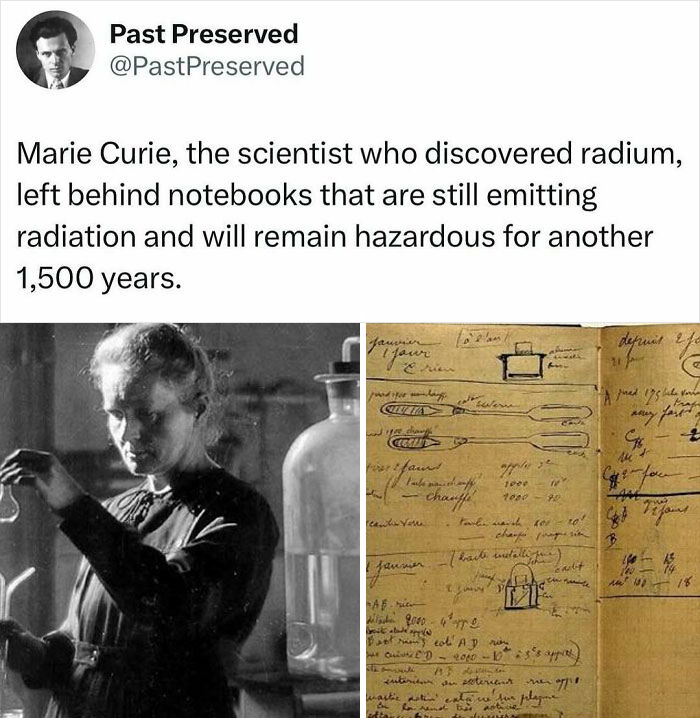
Image credits: pastpreserved
#30
The phrase “mad as a hatter” has its origins in the 18th and 19th centuries, linked to the dangerous working conditions of hat makers. During this time, many hatters used mercury nitrate in the process of curing felt for hats. Prolonged exposure to mercury caused a condition now known as mercury poisoning, which affected the nervous system and led to symptoms such as tremors, mood swings, and erratic behavior. These effects were so common among hat makers that people began associating their unusual behavior with the profession, coining the term “mad as a hatter.” Though often linked to Lewis Carroll’s Alice’s Adventures in Wonderland, the phrase was in use well before the book’s publication
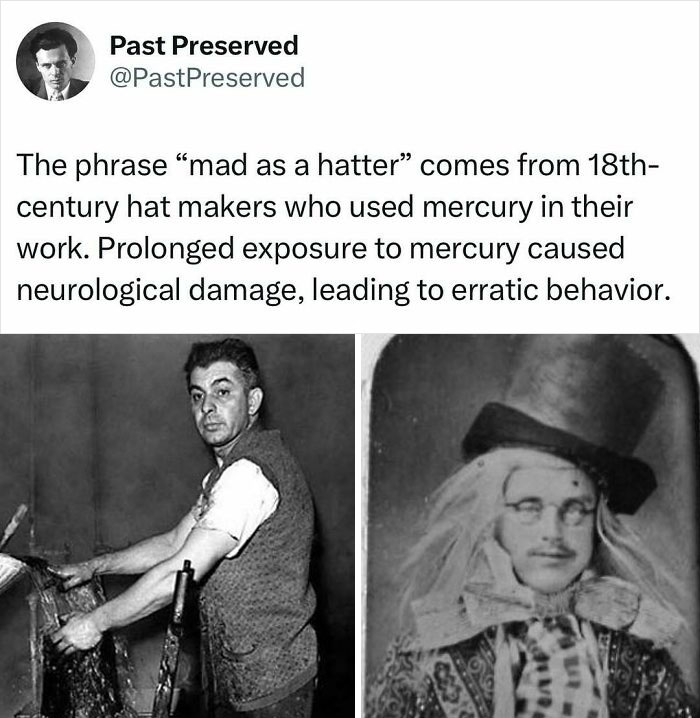
Image credits: pastpreserved
#31
IN EVENT OF MOON DISASTER July 18, 1969 “Fate has ordained that the men who went to the moon to explore in peace will stay on the moon to rest in peace. These brave men, Neil Armstrong and Edwin Aldrin, know that there is no hope for their recovery. But they also know that there is hope for mankind in their sacrifice. These two men are laying down their lives in mankind’s most noble goal: the search for truth and understanding. They will be mourned by their families and friends; they will be mourned by their nation; they will be mourned by the people of the world; they will be mourned by a Mother Earth that dared send two of her sons into the unknown. In their exploration, they stirred the people of the world to feel as one; in their sacrifice, they bind more tightly the brotherhood of man. In ancient days, men looked at stars and saw their heroes in the constellations. In modern times, we do much the same, but our heroes are epic men of flesh and blood. Others will follow, and surely find their way home. Man’s search will not be denied. But these men were the first, and they will remain the foremost in our hearts. For every human being who looks up at the moon in the nights to come will know that there is some corner of another world that is forever mankind.”

Image credits: pastpreserved
#32
In 1914, Sir Ernest Shackleton set out on the Imperial Trans-Antarctic Expedition, aiming to become the first to cross the Antarctic continent. However, his ship, *Endurance*, became trapped in thick pack ice in the Weddell Sea before even reaching the continent. For nearly two years, Shackleton and his 27-man crew endured brutal conditions after the ship was crushed by the ice and sank in 1915. The crew set up camp on the drifting ice floes, hoping for rescue, but as conditions worsened, they embarked on an extraordinary journey. They used lifeboats to reach Elephant Island, where they were still isolated from help. Shackleton and five others then made a daring 800-mile journey in a small open boat, the *James Caird*, to South Georgia Island. Despite treacherous seas and near-impossible navigation, they reached the island and hiked across its mountainous terrain to find help. After several failed attempts, Shackleton finally managed to rescue the entire crew from Elephant Island in August 1916—without a single loss of life. The expedition, though a failure in its original goal, became one of the greatest stories of leadership and survival in polar exploration history.
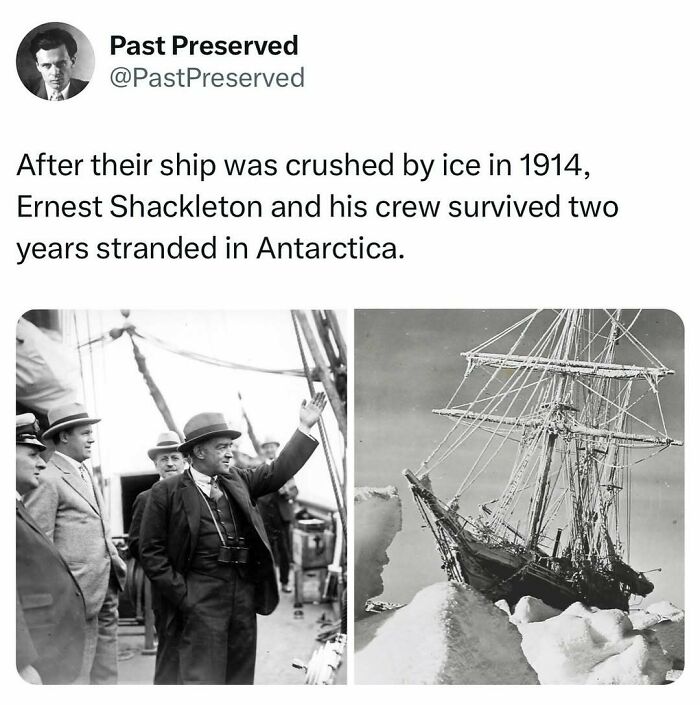
Image credits: pastpreserved
#33
The construction of the World Trade Center’s Twin Towers was a monumental feat of engineering that began in 1966 and changed New York City’s skyline forever. Completed in 1973, the towers stood at 1,368 and 1,362 feet, making them the tallest buildings in the world at the time. Designed by architect Minoru Yamasaki, the towers employed a revolutionary “tube-frame” design, which allowed them to soar to unprecedented heights while remaining incredibly stable. Their sleek exterior featured a steel lattice structure, transferring the building’s weight and creating vast, open office spaces—an architectural breakthrough. Over 200,000 tons of steel and 425,000 cubic yards of concrete were used to build the 110-floor towers, making them not just symbols of American economic power, but of innovation and ambition. The Twin Towers became an instantly recognizable part of the New York skyline and stood as icons of global finance and progress until their tragic loss on September 11, 2001. Their legacy endures, reminding the world of what humanity can achieve when pushing the boundaries of possibility

Image credits: pastpreserved
#34
In 1956, IBM revolutionized data storage with the IBM 350 Disk Storage Unit, the world’s first hard disk drive, introduced alongside the IBM 305 RAMAC computer. This massive drive used a stack of fifty 24-inch disks to hold just 4.5 megabytes of data—a fraction of what even the smallest modern drives can store (equivalent to enough space to store 1 modern iPhone photo). Despite its size, weighing over a ton, the IBM 350 was groundbreaking as it allowed direct, random access to information rather than relying on sequential storage like tapes. This innovation laid the groundwork for all modern data storage, marking a major milestone in computing history.

Image credits: pastpreserved
#35
One of the earliest depictions of Jesus, found in a 200 AD engraving, wasn’t a tribute but a mockery. It shows a man worshiping a crucified figure with a donkey’s head, likely a satirical jab at early Christians.

Image credits: pastpreserved
#36
In 1987, Prince recorded The Black Album, a funk-driven project that was a stark contrast to his more pop-oriented work. The album was set for release, with copies already printed and prepared for distribution, when Prince abruptly canceled it just days before its scheduled debut. He later claimed the album carried a “dark energy” and attributed his change of heart to a spiritual epiphany, reportedly triggered by an intense experience with ecstasy. Warner Bros. recalled the album, making it one of the most infamous unreleased records in music history. Despite the recall, some copies had already made it into circulation, leading to widespread bootlegging throughout the late 1980s and 1990s. The album gained near-mythical status among fans, with unofficial versions selling for high prices. In 1994, Prince briefly allowed an official limited release before pulling it once again. Though The Black Album never had a proper commercial launch, its legend only grew, cementing its reputation as one of the most sought-after bootlegs of all time.

Image credits: pastpreserved
#37
The first photograph of a human was an accident. In 1838, Louis Daguerre captured a daguerreotype of the Boulevard du Temple in Paris. Due to the long exposure—about 10 to 15 minutes—most of the bustling street disappeared, except for a man getting his boots shined. He stood still long enough to be captured, making him the first known person ever photographed. Daguerreotypes required long exposures, so moving subjects vanished, explaining the seemingly empty street. This accidental capture of the boot shiner and his customer proved photography could preserve not just landscapes, but human life. Today, it’s a fascinating glimpse into early photography and a historic moment frozen in time.

Image credits: pastpreserved
#38
In the 1990s, Michael Jackson expressed interest in purchasing Marvel Comics. At the time, Marvel was struggling financially, and Jackson saw an opportunity to bring his creative vision to life. He dreamed of producing a Spider-Man movie and playing the titular role himself. Despite his enthusiasm, the deal never materialized, partly because Marvel wasn’t ready to hand over its intellectual properties and Jackson’s vision raised skepticism in Hollywood. Today, Marvel has become a cinematic giant under Disney, leaving fans to wonder what Jackson’s Spider-Man might have looked like.

Image credits: pastpreserved
#39
Nikola Tesla was a pioneering inventor best known for developing the alternating current (AC) electrical system, which transformed how we use and distribute power today. He also made significant contributions to radio, wireless technology, and early robotics, earning him a reputation as one of history’s most innovative minds. Although he never married and largely avoided personal relationships, Tesla had a deep affection for pigeons, frequently feeding them in New York parks. He formed a unique bond with a particular white pigeon, claiming he loved her in a profound way. Tesla devotedly cared for this pigeon, even nursing her through illness, finding comfort and companionship in their connection amid his isolated and work-focused life

Image credits: pastpreserved
#40
During the filming of The Wizard of Oz, Judy Garland was put on an extreme and unhealthy diet by studio executives. To maintain the youthful look they demanded, she was limited to a diet of coffee, cigarettes, and diet soup, often paired with pills to suppress her appetite and keep her energy up. This grueling regimen reflected the harsh realities of Hollywood at the time, where young stars were pressured to meet impossible standards. Despite these challenges, Garland delivered an iconic performance as Dorothy, though the toll it took on her health and well-being was profound

Image credits: pastpreserved
#41
In 1922, British archaeologist Howard Carter made one of the most significant discoveries in history: the tomb of Pharaoh Tutankhamun. Hidden in the Valley of the Kings, the tomb’s entrance had remained untouched for over 3,000 years. When Carter and his team uncovered the door, they found the seal to be unbroken—a clear sign that no grave robbers had entered since it was sealed in antiquity. Inside, they found an immense collection of treasures, from gold jewelry and statues to a solid gold coffin that held the pharaoh’s mummified body. The wealth of artifacts offered unparalleled insight into the opulence and artistry of ancient Egypt. However, the tomb’s discovery also sparked rumors of a “curse.” Many believed that those who entered the burial site would suffer misfortune. These claims gained traction when several individuals connected to the excavation, including Carter’s financial backer Lord Carnarvon, died shortly after. Despite these eerie coincidences, modern researchers attribute the deaths to natural causes, dismissing the curse as a myth born of public fascination and superstition.

Image credits: pastpreserved
#42
During the height of the Cold War, Soviet Marshal Georgy Zhukov, known for his pivotal role in World War II, was reportedly introduced to Coca-Cola during a visit to the United States in the late 1950s. As a staunch communist and high-ranking official in the USSR, Zhukov was cautious about associating with products from the capitalist West, especially something as iconic as Coca-Cola, which represented American consumerism. To navigate this diplomatic tension, it’s said that Coca-Cola created a special version of the drink for him, sometimes referred to as “white coke.” This version was supposedly packaged in plain bottles with no branding, though details of this arrangement remain unclear and are not fully documented. While the story has been widely shared, the exact circumstances remain somewhat speculative

Image credits: pastpreserved
#43
Mike Tyson was known for his incredible neck strength, which helped him absorb punches and maintain stability in the ring. His neck workouts were intense and a key part of his training regimen. One of the most famous exercises he used was the “neck bridge,” where he would lie on his back, elevate his body with his head and feet, and rock back and forth, strengthening the muscles in his neck. He often performed neck bridges both on his back and stomach to work different angles. Tyson would also use weighted harnesses or straps around his head to perform resistance exercises, pulling against the weight to build strength. The goal of these exercises was to create a thick, strong neck that could withstand the impact of powerful punches. His neck, famously measured at around 20 inches, became one of his defining physical features during his prime fighting years.

Image credits: pastpreserved
#44
In 1967, Muhammad Ali, then the world heavyweight boxing champion, made headlines for refusing to be drafted into the Vietnam War. Ali cited his religious beliefs as a Muslim and strong opposition to the war, famously stating, “I ain’t got no quarrel with them Viet Cong.” His decision was not without consequence; he was stripped of his boxing titles, barred from the ring, and convicted of draft evasion, which carried a five-year prison sentence. Ali’s stance became a symbol of resistance and civil rights, sparking both support and criticism nationwide. He appealed his conviction, and in 1971, the U.S. Supreme Court unanimously overturned it, allowing him to return to boxing and continue his career. His decision remains a landmark example of standing by one’s beliefs despite immense personal sacrifice.

Image credits: pastpreserved
#45
During World War II, Queen Elizabeth II broke royal tradition by joining the Auxiliary Territorial Service, where she trained as a mechanic and military truck driver. At just 18 years old, she learned to repair engines, change tires, and drive heavy vehicles—earning the nickname “Princess Auto Mechanic.” This hands-on experience made her the only British monarch with mechanical training, showcasing her dedication to serving alongside her people during a time of crisis. Her service in the ATS was part of a broader effort to contribute to the war, despite her royal status. Unlike other monarchs who remained largely behind the scenes, she actively participated in the war effort, symbolizing resilience and duty. Decades later, she remained passionate about driving, often taking the wheel of her Land Rover well into her 90s—without ever needing a driver’s license

Image credits: pastpreserved
#46
The abbreviation ‘OMG’ (Oh My God) dates back further than you might think —it was first recorded in a 1917 letter from British Admiral Lord Fisher to Winston Churchill. In the letter, Fisher joked about a new order of knighthood, writing, ‘I hear that a new order of Knighthood is on the tapis-O.M.G. (Oh!My God!)! This early use of the now-common internet slang shows that acronyms were already being used creatively in correspondence long before the digital age

Image credits: pastpreserved
#47
Vincent van Gogh only sold one painting during his lifetime, The Red Vineyard, in 1888. The painting was purchased by Belgian art dealer Anna Boch for 400 francs, which is approximately $2,000 today. Despite creating over 2,000 works of art, van Gogh struggled financially and received little recognition for his work while alive. Van Gogh’s lack of commercial success during his lifetime contrasts sharply with the immense fame he gained after his death. Today, he is regarded as one of the most influential artists in history, with his paintings now selling for millions of dollars.

Image credits: pastpreserved
#48
In one of the most puzzling aviation mysteries, a Boeing 727 disappeared from Angola’s Quatro de Fevereiro Airport in Luanda on May 25, 2003. The aircraft, previously used for transporting fuel, had been grounded for maintenance and was undergoing refurbishments when it was suddenly taxied onto the runway without clearance. Despite attempts by air traffic control to establish communication, the plane took off without any lights or transponder signals, vanishing into the sky. The 727, piloted by two men—an American flight engineer, Ben Padilla, and a mechanic, John Mutantu—has not been seen since. Despite an international investigation led by the FBI and the CIA, the aircraft’s whereabouts remain unknown. Theories have ranged from a hijacking to a criminal operation or even use by terrorist groups, but no solid evidence has ever emerged. The case remains one of aviation’s great unsolved mysteries, with no trace of the plane or its crew discovered to this day

Image credits: pastpreserved
#49
Judy, a purebred liver-and-white English Pointer, became the only animal officially recognized as a prisoner of war during World War II. Her story began in 1936 when she was adopted as a ship mascot by the crew of the HMS Gnat, a British gunboat stationed on the Yangtze River in China. Judy quickly became beloved for alerting the crew to danger, especially during encounters with Japanese forces. In 1942, after her ship was sunk, Judy and her crew were captured by Japanese forces and sent to a brutal prisoner of war camp in Sumatra. There, she saved lives by distracting guards and finding water for her fellow prisoners. Frank Williams, a POW who cared for her, registered Judy as a prisoner of war to protect her from execution. After the war, she was awarded the Dickin Medal, the animal equivalent of the Victoria Cross, and lived happily with Williams, cementing her legacy as a true war hero.

Image credits: pastpreserved
#50
In 1975, advertising executive Gary Dahl introduced one of the quirkiest fads of the decade: the Pet Rock. What started as a humorous idea became a cultural phenomenon, as Dahl marketed smooth stones as the ultimate low-maintenance “pets” that didn’t need feeding, walking, or grooming. Each rock came nestled in a cardboard box with straw bedding, complete with a manual on “care and training.” Dahl’s tongue-in-cheek approach struck a chord, and millions of people bought Pet Rocks, making him a millionaire nearly overnight. Though the craze was short-lived, the Pet Rock is remembered as a symbol of the 1970s’ playful consumer culture and a brilliant example of creative marketing.

Image credits: pastpreserved
#51
The Hollywood Sign originally read “Hollywoodland” when it was built in 1923 to advertise a real estate development. The 50-foot-tall letters were illuminated with 4,000 bulbs, designed to attract buyers. Though it was meant to be temporary, the sign endured and became a symbol of the entertainment industry. In the late 1940s, the “land” was removed, reflecting its shift from a real estate ad to a cultural icon. Restored and maintained over the years, the Hollywood Sign now stands as a globally recognized emblem of the film industry and Los Angeles.

Image credits: pastpreserved
#52

Image credits: pastpreserved
#53
Methuselah, a Great Basin bristlecone pine (Pinus longaeva), is the oldest known living tree in the world, located in California’s White Mountains. At over 4,800 years old, its age has been confirmed through tree-ring dating. To protect it from vandalism, the U.S. Forest Service keeps its exact location secret, ensuring the tree’s survival. Methuselah’s longevity highlights the resilience of bristlecone pines, which thrive in harsh, high-altitude environments. Despite extreme weather, it continues to grow slowly. While Methuselah holds the record, other bristlecone pines in the area are also ancient, some living for over 4,000 years, emphasizing the need to safeguard such natural wonders.

Image credits: pastpreserved
#54
As the RMS Titanic sank into the icy Atlantic on April 15, 1912, the ship’s eight-member band famously played music to help calm passengers amid the chaos. Led by violinist Wallace Hartley, the musicians continued to play as the ship listed and lifeboats filled, reportedly performing hymns like “Nearer, My God, to Thee.” Their courage and commitment provided solace in the ship’s final moments, and all eight musicians perished in the disaster. Today, the Titanic band is remembered as a powerful symbol of bravery and selflessness, embodying calm in one of history’s most harrowing maritime tragedies.

Image credits: pastpreserved
#55
The 1970 whale explosion, also known as the Exploding Whale Incident, took place in Florence, Oregon, when local authorities decided to use dynamite to dispose of a 45-foot, 8-ton beached sperm whale. Officials believed the explosion would send the remains into the ocean, leaving scavengers to clean up the rest. However, the plan went disastrously wrong when the blast sent massive chunks of whale blubber flying over 800 feet, damaging cars, smashing windows, and nearly injuring bystanders. Despite the effort, much of the whale remained on the beach, and the incident became infamous for its bizarre and unintended consequences

Image credits: pastpreserved
#56
During Prohibition (1920–1933), the U.S. banned the production, sale, and transportation of alcohol. This gave rise to moonshiners, people who illegally made and distributed alcohol, often operating in remote areas to avoid detection. To outsmart authorities, some moonshiners wore “cow shoes,” wooden blocks carved to resemble cow hooves. These clever inventions disguised their footprints as animal tracks, making it harder for law enforcement to trace their paths to hidden stills.

Image credits: pastpreserved
#57
In 1926, Harry Houdini, the legendary magician and escape artist, died under shocking circumstances on Halloween. Just days earlier, Houdini was approached by a college student who asked if it was true he could withstand any punch to the stomach. Without warning, the student struck Houdini before Houdini had time to prepare, allegedly rupturing his appendix. Houdini continued to perform despite severe pain but eventually succumbed to peritonitis. His untimely death added an eerie twist to his already mysterious life.

Image credits: pastpreserved
#58
Mark Twain, born Samuel Langhorne Clemens on November 30, 1835, entered the world shortly after Halley’s Comet made its 1835 perihelion. In 1909, Twain remarked, “I came in with Halley’s Comet in 1835. It is coming again next year, and I expect to go out with it.” True to his prediction, Twain passed away on April 21, 1910, just a day after the comet’s closest approach to Earth. This remarkable coincidence has since become a notable aspect of Twain’s legacy, intertwining his life with a celestial event that occurs approximately every 76 years.

Image credits: pastpreserved
#59
In 1989, during his visit to the United States, Russian President Boris Yeltsin found himself in a Houston grocery store, overwhelmed by the sheer abundance of goods lining the shelves. For a leader from the Soviet Union, where shortages and rationing were a daily reality, the sight of endless rows of food, products, and choices was both staggering and eye-opening. Yeltsin later described the experience as a moment of deep despair for the Soviet people. The stark contrast between the consumer-rich environment of the U.S. and the scarcity back home painted a vivid picture of the economic challenges facing the USSR at the time. This visit highlighted the growing divide between East and West and would become a symbol of the fundamental changes that were soon to reshape the world.

Image credits: pastpreserved
#60
In the late 1800s, Nikola Tesla briefly worked for Thomas Edison after immigrating to the United States. Tesla was tasked with improving Edison’s direct current (DC) generators and was promised $50,000 for his efforts—a massive sum at the time. After months of hard work, Tesla delivered, but Edison refused to pay, allegedly dismissing the promise as a joke. Feeling betrayed, Tesla left Edison’s company and later pioneered alternating current (AC) technology, which ultimately became the dominant method for electrical power distribution. This rivalry became one of the most famous in the history of innovation, contrasting Tesla’s visionary approach with Edison’s practical, business-minded strategies.

Image credits: pastpreserved
#61
In 1974, North Korea ordered 1,000 Volvo 144 sedans from Sweden, but when it came time to pay, North Korea simply never did. The cars were delivered, but North Korea defaulted on the bill and ignored Sweden’s repeated demands for payment. The “heist” left the Swedish government sending annual invoices, which remain unpaid to this day. The Volvos were seen on North Korean roads for years, becoming a unique symbol of the enduring, and likely uncollectible, international debt.

Image credits: pastpreserved
#62
Harry Houdini, the world-famous magician and escape artist, was known for his daring stunts and unmatched skill in sleight of hand. Offstage, he had a fierce skepticism of the mystical and targeted spiritualists and psychics who preyed on vulnerable people. Believing they were frauds, he made it his mission to expose their deceit. Houdini often attended séances in disguise, publicly debunked so-called miracle workers, and even testified before Congress to fight against fortune-telling. His crusade was partly fueled by grief after losing his mother, hoping to contact her through a medium only to find it was a sham. His relentless efforts cemented his legacy not just as an entertainer but as a defender of truth.

Image credits: pastpreserved
#63
In 1988, the United States Coast Guard and Garrett AiResearch modified a Dassault Falcon 20C, a business jet typically used for corporate travel, by fitting it with a Garrett TFE1042 afterburning turbofan engine. Afterburners, usually found on military jets, inject fuel directly into the exhaust stream to produce an intense burst of additional thrust. This allows fighter jets to achieve supersonic speeds but comes at the cost of extreme fuel consumption. The Falcon 20 was used as a testbed for this engine, which was being developed for the U.S. Navy’s Vought A-7 Corsair II attack aircraft upgrade program. Despite its impressive power, afterburners are impractical for business jets. Their immense fuel use drastically shortens range, making them inefficient for commercial applications. The modified Falcon 20C was retired from testing, and no other business jet has been equipped with an afterburner since.

Image credits: pastpreserved
#64
In 2007, Tennessee death row inmate Philip Workman made a surprising final request before his execution. Convicted of taking the life of a police officer during a robbery in 1981, Workman declined a last meal for himself and instead asked for a large vegetarian pizza to be donated to a local homeless person. Though prison officials denied his request, news of his gesture spread, inspiring people across the country to donate pizzas to homeless shelters in his honor. Workman’s request became a symbol of compassion and sparked conversations about redemption and humanity, even in the final moments of life. This unexpected act left a lasting legacy beyond his controversial case

Image credits: pastpreserved
#65
In the final years of his life, Nikola Tesla, the brilliant inventor and visionary, lived in relative obscurity at the New Yorker Hotel. His last known photograph, taken in 1943 shortly before his death, captures the frailty of a man who had once electrified the world with his genius. Though aged and weary, his sharp gaze reflects the mind that revolutionized modern technology. Tesla died alone in his hotel room at the age of 86, leaving behind over 300 patents and countless contributions to science. While he passed in near poverty, his legacy as a pioneer of wireless communication, alternating current, and countless other innovations continues to shape the world today.

Image credits: pastpreserved
#66
In 1896, Walter Arnold became the first person ever to receive a speeding ticket for driving 8 miles per hour in a zone with a speed limit of 2 mph in Paddock Wood, Kent, England. He was pursued by a police officer on a bicycle, who eventually caught up to him and issued a fine of one shilling. Arnold’s speeding violation reflects the early days of the automobile, when society was just beginning to grapple with the implications of motorized travel. Today, his infraction is viewed as a humorous milestone in the history of traffic law enforcement.

Image credits: pastpreserved
#67
Winston Churchill, Britain’s future prime minister and one of the most influential leaders of the 20th century, found himself navigating America’s Prohibition laws during a 1931 lecture tour in the United States. While in New York City, Churchill was struck by a car, suffering injuries that required rest and treatment. To aid his recovery, his doctor prescribed “the ingestion of alcoholic spirits,” allowing Churchill to legally bypass Prohibition, which had banned alcohol consumption. Known for his fondness for alcohol, Churchill reportedly kept the prescription with him to ensure he could enjoy his favorite drinks without issue. The prescription read: “This is to certify that the post-accident convalescence of the Hon. Winston S. Churchill necessitates the use of alcoholic spirits especially at meal times. The quantity is naturally indefinite but the minimum requirements would be 250 cubic centimeters” His visit to America was part of a broader effort to improve his finances through public speaking, and this incident offers a glimpse into the unintended quirks of Prohibition and Churchill’s enduring determination—even in the face of injury.

Image credits: pastpreserved
#68
In Ancient Rome, people buried their beloved dogs with care, often inscribing heartfelt messages on the graves. These inscriptions reflect the deep bond Romans shared with their pets, honoring them as true family members.

Image credits: pastpreserved
#69
At the height of his power in the late 1980s, Pablo Escobar was one of the richest criminals in history, reportedly earning up to $420 million a week through his drug empire. With his immense wealth, he offered to pay off Colombia’s entire national debt—estimated at around $10 billion at the time—in exchange for a guarantee that he would never be extradited to the United States. Escobar feared extradition more than anything, as it meant facing trial and imprisonment under U.S. law rather than the more lenient Colombian system. Despite his offer, the Colombian government refused, maintaining its extradition treaty with the U.S. In response, Escobar launched a violent campaign against the state, including bombings, assassinations, and attacks on officials who supported extradition. His efforts ultimately led to the Colombian government banning extradition in 1991, just before he surrendered to authorities and was placed in his self-built luxury prison, La Catedral. However, his reign of terror continued, and after escaping in 1992, he was eventually tracked down and killed by security forces in 1993.

Image credits: pastpreserved
#70
Frank Sinatra’s ties to the mafia were so strong that the FBI compiled a massive 2,000-page file on him, tracking his alleged connections to organized crime for decades. While never charged with a crime, Sinatra was known to associate with notorious mob figures, including Lucky Luciano and Sam Giancana. His friendships with these underworld figures fueled speculation that he acted as a liaison between the mafia and powerful politicians, including John F. Kennedy. Despite the scrutiny, Sinatra always denied any criminal involvement, insisting his relationships were purely social. However, the rumors followed him throughout his career, even inspiring the character of Johnny Fontane in The Godfather. Whether he was deeply involved or simply a well-connected entertainer, his close ties to the mob remain one of the most intriguing aspects of his legendary life

Image credits: pastpreserved
#71
In 2011, Michael Jackson’s iconic red leather jacket from the Thriller music video sold at auction for $1.8 million. Designed by Deborah Nadoolman Landis, the jacket became one of the most recognizable pieces of fashion in music history. The buyer, Milton Verret, called it “the greatest piece of rock and roll memorabilia in history” and has since used it to raise funds for charities by showcasing it at exhibitions and events. Proceeds from the auction were donated to an animal sanctuary that housed Jackson’s Bengal tigers after he left Neverland Ranch. The jacket remains a powerful symbol of the King of Pop’s cultural legacy

Image credits: pastpreserved
#72
In the 1500s, accused witches in England faced a brutal test called “swimming a witch.” Believed that water, a pure element, would reject witches, the accused were bound and thrown into water. Floating meant guilt, while sinking proved innocence—but often resulted in drowning. Though not officially sanctioned by law, communities carried out this cruel ordeal during the height of witchcraft hysteria. This grim practice reflects the fear and prejudice fueling the European witch hunts, where accusations often targeted women and were driven by superstition or personal vendettas. Though “swimming a witch” eventually faded, it remains a chilling reminder of the dangers of mass panic and scapegoating in history

Image credits: pastpreserved
#73
Stubby was found wandering the grounds of the Yale University campus in New Haven, Connecticut, in July 1917, while members of the 102nd Infantry were training. He hung around as the men drilled and one soldier in particular, Corporal James Robert Conroy developed a fondness for him. Stubby served with the 102nd Infantry Regiment in the trenches in France for 18 months and participated in four offensives and 17 battles. In his first year of battle, Stubby was injured by mustard gas. After he recovered, he returned with a specially designed gas mask to protect him. He thus learned to warn his unit of mustard gas attacks, locate wounded soldiers in no man’s land, and since he could hear the whine of incoming artillery shells before humans-became very adept at alerting his unit when to duck for cover. He saved his regiment from surprise mustard gas attacks, found and comforted the wounded, and allegedly once caught a German soldier by the seat of his pants, holding him there until American soldiers found him. After returning home, Stubby became a celebrity and marched in, and normally led, many parades across the country. He met Presidents Woodrow Wilson, Calvin Coolidge, and Warren G. Harding. He died in his sleep in March 1926: his remains are at the Smithsonian National Museum of American History

Image credits: pastpreserved
#74
Terry Fox was a Canadian athlete and cancer activist who became a national hero for his inspiring “Marathon of Hope.” In 1980, after losing his right leg to osteosarcoma (a form of bone cancer), Terry set out to run across Canada to raise money and awareness for cancer research. Running with a prosthetic leg, he covered an average of 26 miles per day, the equivalent of a marathon, starting in St. John’s, Newfoundland. Terry’s journey captured the hearts of Canadians, but after running 3,339 miles over 143 days, his cancer returned, forcing him to stop in Thunder Bay, Ontario. Despite not completing his goal of running across the country, Terry’s legacy endures. The Terry Fox Foundation has since raised over $850 million for cancer research, and annual Terry Fox Runs are held around the world in his honor. His courage, determination, and selflessness have made him a symbol of hope and perseverance in the fight against cancer

Image credits: pastpreserved
#75
Gigantopithecus blacki was an extinct species of giant ape that lived during the Pleistocene epoch, roughly 1 million to 300,000 years ago. It was the largest known ape, estimated to stand around 3 meters (10 feet) tall and weigh up to 540 kg (1,200 pounds). The species lived in the forests of what is now China, India, and Vietnam. Fossils of Gigantopithecus blacki, primarily teeth and jaw fragments, suggest it was herbivorous, likely consuming bamboo and other plant material, similar to modern giant pandas. Its massive size has sparked comparisons to mythical creatures like Bigfoot, though there is no evidence to suggest Gigantopithecus survived into modern times

Image credits: pastpreserved
#76
Tim Samaras was a renowned storm chaser known for pioneering tornado research. He tragically died on May 31, 2013 while chasing a tornado near El Reno, Oklahoma. His work significantly advanced the understanding of tornado dynamics

Image credits: pastpreserved
#77
During the Apollo 11 mission in 1969, astronaut Buzz Aldrin quietly performed a religious ceremony that became the first sacrament ever celebrated on the Moon. Aldrin, a Presbyterian elder, brought a small communion kit with bread and wine, which he consumed in solitude shortly after landing on the lunar surface. NASA kept the event low-profile due to ongoing legal issues surrounding religious activities in space. Aldrin later reflected on the moment as deeply personal, blending his faith with the historic achievement of humankind’s first steps on another world

Image credits: pastpreserved
#78
Before alarm clocks were commonly available, industrial towns in Britain and Ireland relied on “knocker-uppers” to wake people for early shifts during the 19th and early 20th centuries. These human alarms used sticks to tap on windows or pea-shooters for higher accuracy, ensuring clients were up on time. The profession persisted into the 1920s and, in some areas, as late as the 1970s. They were paid weekly for their services, crucial for factory and dock workers needing to rise as early as 3 a.m. This unique trade faded as alarm clocks became affordable and reliable

Image credits: pastpreserved
#79
On the morning of April 14, 1912, the very day the Titanic struck the iceberg that would lead to its sinking, Captain Edward Smith reportedly canceled a scheduled lifeboat drill. Such drills were standard practice on passenger ships, meant to prepare crew and passengers for emergencies by familiarizing them with evacuation procedures and lifeboat usage. Historians speculate on why Captain Smith made this decision, with theories ranging from overconfidence in the Titanic’s “unsinkable” design to logistical concerns about passenger inconvenience. Tragically, the lack of preparedness among passengers and crew contributed to the chaos during the ship’s sinking, with many lifeboats launched only partially filled despite the Titanic not carrying enough lifeboats for all onboard. This canceled drill has become a key detail in the Titanic’s story, symbolizing the complacency and misplaced confidence that characterized the ship’s doomed voyage. It serves as a sobering reminder of the importance of preparation and vigilance, even in seemingly “unsinkable” circumstances.

Image credits: pastpreserved
#80
In 1982, Larry Walters, later known as “Lawn Chair Larry,” turned a backyard dream into a bizarre and daring reality. Using a lawn chair and 45 weather balloons filled with helium, he launched himself 15,000 feet into the sky over San Pedro, California. Equipped with a pellet gun, sandwiches, beer, and a CB radio, Larry’s plan was to gently drift across the desert. Instead, he drifted into controlled airspace, startling pilots and causing a stir in the aviation world. After safely descending, Larry became entangled in power lines but managed to avoid injury. The FAA fined him $1,500 for violating airspace regulations, but his stunt captivated the public, making him a symbol of ambition and eccentricity

Image credits: pastpreserved
#81
In 1941, Swiss engineer Georges de Mestral embarked on a hunting trip in the Alps with his dog. Upon returning, he noticed burrs clinging tenaciously to his clothing and his dog’s fur. Curious about their sticking mechanism, de Mestral examined the burrs under a microscope and discovered tiny hooks that latched onto loops in fabric and fur. This observation inspired him to develop a synthetic fastening system that mimicked this natural hook-and-loop mechanism. After years of research and refinement, he patented his invention in 1955, naming it “Velcro,” a combination of the French words “velours” (velvet) and “crochet” (hook). Today, Velcro is widely used in various applications, from clothing and footwear to aerospace technology, exemplifying how nature can inspire innovative solutions.

Image credits: pastpreserved
#82
In 1925, a daring con artist named Victor Lustig pulled off one of history’s boldest scams—selling the Eiffel Tower. Lustig, posing as a government official, convinced scrap metal dealers that the iconic tower was too costly to maintain and was set to be dismantled. He arranged a private “auction” and sold the Eiffel Tower not once but twice, disappearing with the money before the buyers realized they’d been duped. Known as “The Man Who Sold the Eiffel Tower,” Lustig’s con became one of the most audacious in history, highlighting his charm, audacity, and mastery of deception

Image credits: pastpreserved
#83
In ancient Egypt, cats were considered sacred animals, often linked to the goddess Bastet, a deity of home, fertility, and protection. This reverence for cats dates back as early as 2000 BCE. Families deeply valued their feline companions, and when a cat passed away, it was a significant event. As part of the mourning process, family members would shave off their eyebrows to visibly express their grief and respect for the cat’s sacred role. Cats in ancient Egypt were more than just pets—they were protectors, keeping homes free of pests, and were seen as symbols of divine qualities. Their sacred status was so important that harming or killing a cat, even accidentally, could result in severe punishment. The mourning ritual, including shaving eyebrows, highlights how integral cats were to both daily life and spiritual beliefs in ancient Egyptian society

Image credits: pastpreserved
#84
Nicholas II, the last Emperor of Russia, reigned from 1894 until his abdication in 1917, during a tumultuous period of Russian history. His reign was marked by significant political and social unrest, including the 1905 Revolution, the Russo-Japanese War, and the disastrous involvement in World War I, all of which contributed to the eventual collapse of the Romanov dynasty. Beyond his role as a ruler, Nicholas had a deep personal love for art and photography. Photography became a significant hobby for him, and he often used his camera to document personal moments with his family. He was fascinated by the new technology, which allowed him to capture intimate scenes from his everyday life, including playful moments with his children and wife, Alexandra Feodorovna. His family, including his children, shared this interest, and many of their private moments were preserved through photographs, giving us a rare glimpse into their personal lives during the twilight years of Imperial Russia. In addition to photography, Nicholas was also an admirer of art and culture. However, despite these personal interests, his rule is often remembered for his detachment from critical political matters, which contributed to his downfall. His passion for hunting, sports, and family life, though personal joys, often appeared to outweigh his engagement with the dire issues facing his empire

Image credits: pastpreserved
#85
Invented in 1st-century Roman Egypt by Hero of Alexandria, this early vending machine was designed for temples to dispense holy water. It worked by using a coin-operated system: when a coin was dropped into the machine, it landed on a small platform attached to a lever. The weight of the coin tipped the lever, opening a valve that allowed a precise amount of holy water to flow out. Once the coin fell off the platform, the lever returned to its original position, closing the valve. This ingenious invention not only automated the process but ensured people didn’t take more than their share, making it one of the earliest examples of mechanical innovation. Long before vending machines delivered snacks, they were dispensing blessings!

Image credits: pastpreserved
#86
Arnold Schwarzenegger owns an M47 Patton tank, the same model he trained on during his Austrian Army service in 1965. He purchased the tank and had it shipped from Austria to California for $20,000, making it one of his most unique possessions. The M47 Patton tank was an American-made model widely used during the mid-20th century. Schwarzenegger has also used the tank in charitable programs, offering rides to motivate and reward students for their achievements.

Image credits: pastpreserved
#87
New York City 1933 🏙️ New York City’s transformation into a global metropolis is deeply tied to the Industrial Revolution and the waves of immigration that shaped its development. Settled by the Dutch in 1624 as New Amsterdam, it was a modest trading post, but by the early 19th century, its strategic location and natural harbor made it a key hub for commerce and industry. The Industrial Revolution accelerated its growth, as factories, shipyards, and textile mills sprung up across the city, driving an economic boom. The completion of the Erie Canal in 1825 further cemented New York’s role as a commercial powerhouse, connecting the city to the Great Lakes and opening up vast new markets. Massive immigration, particularly from Europe, provided a labor force for its factories, leading to rapid urbanization. Neighborhoods like the Lower East Side grew quickly, while skyscrapers and bridges began to define the city’s skyline. The rise of industries such as steel, textiles, and finance, along with the city’s burgeoning transportation network, transformed New York into the economic engine of the United States by the late 19th century. The Industrial Revolution not only shaped its physical landscape but also laid the foundation for New York City’s role as a leading global city

Image credits: pastpreserved
#88
Before Jimi Hendrix became a legend, he worked as a backup guitarist for acts like Little Richard and The Isley Brothers. But his talent couldn’t be contained—he often improvised and stole the spotlight, leading to him getting fired for showing off too much. His flashy playing may have cost him gigs, but it also set the stage for his rise as one of the greatest guitarists of all time

Image credits: pastpreserved
#89
Cleopatra, the famous Egyptian queen, was known for her elaborate beauty rituals, one of which included using crushed beetles and ants to create her signature red lipstick. This practice relied on carmine, a deep red pigment derived from cochineal insects, which was later refined and adopted in cosmetics worldwide. Even today, carmine remains a common ingredient in some modern lipsticks and food dyes. While it provides vibrant, long-lasting color, its use has sparked debate among those advocating for vegan and cruelty-free products. The legacy of Cleopatra’s beauty practices serves as a reminder of the enduring influence of ancient innovations in modern cosmetics

Image credits: pastpreserved
#90
In 1969, over 600 million people watched the Apollo 11 Moon landing, but the original high-resolution tapes were accidentally erased in the 1980s when NASA reused them during a tape shortage. Thankfully, TV broadcasts like those from CBS preserved the event, allowing NASA to remaster surviving footage from lower-resolution copies in 2009. Though the original tapes are lost, the restored footage ensures this monumental moment in history lives on. It’s a reminder of humanity’s achievements—and the importance of preserving them for future generations.

Image credits: pastpreserved
#91
Did you know the Statue of Liberty wasn’t always green? When France gifted Lady Liberty to the U.S., she was a 305-foot statue with reddish-brown copper skin. Her color change is thanks to about 30 years’ worth of chemistry in the air of New York City harbor.

Image credits: pastpreserved
#92
The 1883 Krakatoa eruption was one of the most powerful in history, producing the loudest recorded sound. The blast was heard over 3,000 miles away and sent shockwaves around the globe. It was so intense that sailors 40 miles away suffered ruptured eardrums. Barometers worldwide recorded sudden pressure jumps, and the explosion’s force was unlike anything ever measured. Beyond the sound, the eruption triggered tsunamis that claimed over 36,000 lives, wiping out coastal villages in Java and Sumatra. Some waves reached 100 feet high, and ash darkened skies for days. Global temperatures dropped, and vivid red sunsets appeared for months. Some believe Edvard Munch’s The Scream was inspired by the eerie skies after the disaster.

Image credits: pastpreserved
#93
Operation Acoustic Kitty was a secret Cold War experiment conducted by the CIA in the 1960s aimed at using cats as covert listening devices to spy on the Soviet Union. The project involved surgically implanting a microphone and radio transmitter inside a cat, essentially turning it into a living surveillance tool. The idea was that cats, being inconspicuous and able to move freely in and out of buildings, could be deployed to eavesdrop on conversations. Operation Acoustic Kitty ultimately failed because of the logistical issues involved in training and controlling an animal for such a complex task. The project was considered impractical and was scrapped after spending an estimated $20 million. It remains one of the more bizarre examples of Cold War espionage efforts

Image credits: pastpreserved
from Bored Panda https://ift.tt/XgsIqRt
via IFTTT source site : boredpanda